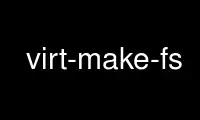
This is the command virt-make-fs that can be run in the OnWorks free hosting provider using one of our multiple free online workstations such as Ubuntu Online, Fedora Online, Windows online emulator or MAC OS online emulator
PROGRAM:
NAME
virt-make-fs - Make a filesystem from a tar archive or files
SYNOPSIS
virt-make-fs [--options] input.tar output.img
virt-make-fs [--options] input.tar.gz output.img
virt-make-fs [--options] directory output.img
DESCRIPTION
Virt-make-fs is a command line tool for creating a filesystem from a tar archive or some
files in a directory. It is similar to tools like mkisofs(1), genisoimage(1) and
mksquashfs(1). Unlike those tools, it can create common filesystem types like ext2/3 or
NTFS, which can be useful if you want to attach these filesystems to existing virtual
machines (eg. to import large amounts of read-only data to a VM).
To create blank disks, use virt-format(1). To create complex layouts, use guestfish(1).
Basic usage is:
virt-make-fs input output.img
where "input" is either a directory containing files that you want to add, or a tar
archive (either uncompressed tar or gzip-compressed tar); and output.img is a disk image.
The input type is detected automatically. The output disk image defaults to a raw ext2
sparse image unless you specify extra flags (see "OPTIONS" below).
FILESYSTEM TYPE
The default filesystem type is "ext2". Just about any filesystem type that libguestfs
supports can be used (but not read-only formats like ISO9660). Here are some of the more
common choices:
ext3
Note that ext3 filesystems contain a journal, typically 1-32 MB in size. If you are
not going to use the filesystem in a way that requires the journal, then this is just
wasted overhead.
ntfs or vfat
Useful if exporting data to a Windows guest.
minix
Lower overhead than "ext2", but certain limitations on filename length and total
filesystem size.
EXAMPLE
virt-make-fs --type=minix input minixfs.img
TO PARTITION OR NOT TO PARTITION
Optionally virt-make-fs can add a partition table to the output disk.
Adding a partition can make the disk image more compatible with certain virtualized
operating systems which don't expect to see a filesystem directly located on a block
device (Linux doesn't care and will happily handle both types).
On the other hand, if you have a partition table then the output image is no longer a
straight filesystem. For example you cannot run fsck(8) directly on a partitioned disk
image. (However libguestfs tools such as guestfish(1) and virt-resize(1) can still be
used).
EXAMPLE
Add an MBR partition:
virt-make-fs --partition -- input disk.img
If the output disk image could be terabyte-sized or larger, it's better to use an
EFI/GPT-compatible partition table:
virt-make-fs --partition=gpt --size=+4T --format=qcow2 input disk.img
EXTRA SPACE
Unlike formats such as tar and squashfs, a filesystem does not "just fit" the files that
it contains, but might have extra space. Depending on how you are going to use the
output, you might think this extra space is wasted and want to minimize it, or you might
want to leave space so that more files can be added later. Virt-make-fs defaults to
minimizing the extra space, but you can use the --size flag to leave space in the
filesystem if you want it.
An alternative way to leave extra space but not make the output image any bigger is to use
an alternative disk image format (instead of the default "raw" format). Using
--format=qcow2 will use the native qemu/KVM qcow2 image format (check your hypervisor
supports this before using it). This allows you to choose a large --size but the extra
space won't actually be allocated in the image until you try to store something in it.
Don't forget that you can also use local commands including resize2fs(8) and
virt-resize(1) to resize existing filesystems, or rerun virt-make-fs to build another
image from scratch.
EXAMPLE
virt-make-fs --format=qcow2 --size=+200M input output.img
OPTIONS
--help
Display brief help.
--floppy
Create a virtual floppy disk.
Currently this preselects the size (1440K), partition type (MBR) and filesystem type
(VFAT). In future it may also choose the geometry.
--size=<N>
--size=+<N>
-s <N>
-s +<N>
Use the --size (or -s) option to choose the size of the output image.
If this option is not given, then the output image will be just large enough to
contain all the files, with not much wasted space.
To choose a fixed size output disk, specify an absolute number followed by
b/K/M/G/T/P/E to mean bytes, Kilobytes, Megabytes, Gigabytes, Terabytes, Petabytes or
Exabytes. This must be large enough to contain all the input files, else you will get
an error.
To leave extra space, specify "+" (plus sign) and a number followed by b/K/M/G/T/P/E
to mean bytes, Kilobytes, Megabytes, Gigabytes, Terabytes, Petabytes or Exabytes. For
example: --size=+200M means enough space for the input files, and (approximately) an
extra 200 MB free space.
Note that virt-make-fs estimates free space, and therefore will not produce
filesystems containing precisely the free space requested. (It is much more expensive
and time-consuming to produce a filesystem which has precisely the desired free
space).
--format=<fmt>
-F <fmt>
Choose the output disk image format.
The default is "raw" (raw sparse disk image).
--type=<fs>
-t <fs>
Choose the output filesystem type.
The default is "ext2".
Any filesystem which is supported read-write by libguestfs can be used here.
--label=<LABEL>
Set the filesystem label.
--partition
--partition=<parttype>
If specified, this flag adds an MBR partition table to the output disk image.
You can change the partition table type, eg. --partition=gpt for large disks.
For MBR, virt-make-fs sets the partition type byte automatically.
-v
--verbose
Enable debugging information.
-V
--version
Display version number and exit.
-x Enable libguestfs trace.
Use virt-make-fs online using onworks.net services
